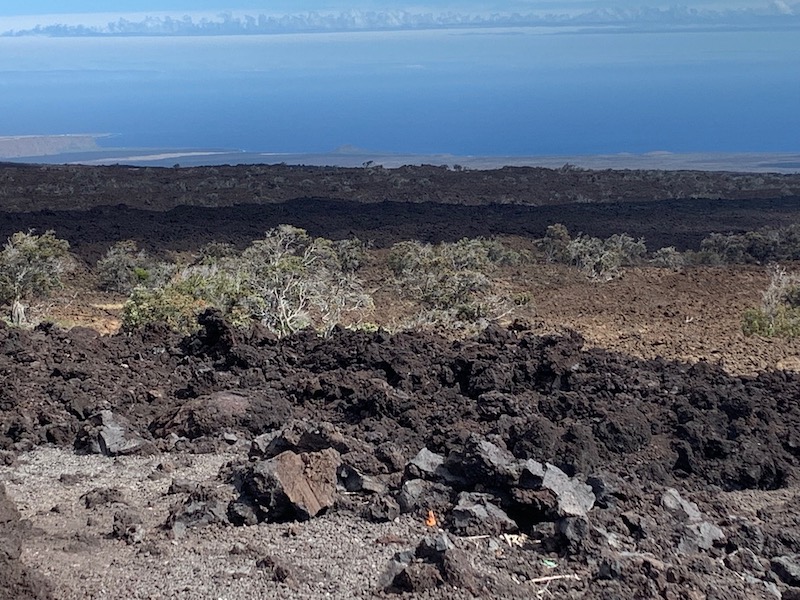Back in the 60’s, give or take, a developer subdivided a rough lava field on the southwestern slope of Mauna Loa (Big Island, Hawaii). Mauna Loa is the largest active volcano in the world and earth’s tallest mountain, at over 32,000 feet from ocean bottom to top. The developer marketed these “parcels of paradise” to mainlanders, I am told, by late night television. Many parcels were sold sight-unseen to people who dreamt of cashing it all in or perhaps retiring in the Hawaiian isles. Only, most parcels are jumbles of lava rock requiring extensive bulldozing in order to build – almost impossible. Sure, you might enjoy a distant view of the ocean, but there is no real beach access and certainly no palm trees. The only way to provide water is either by catchment – rainwater – or, for those who cannot afford to install a catchment system, by filling large jugs at the local Ace Hardware store.
Many of those early purchasers abandoned their dreams of a tropical retirement when they came to check out their parcels. Some purchasers built anyway, but because of the terrain, property values have remained perennially depressed. This is not a wealthy or fancy part of Hawaii. Nonetheless, St. Jude’s Episcopal Mission thrives.
St. Jude’s thrives because it exists for a purpose. Not only does St. Jude’s offer Sunday services to the community, it offers weekly showers to those who cannot afford the catchment water system and have no reasonable means to bathe. Each Saturday, church members staff the showers where people line-up next to the church building to enjoy a warm shower, receive a clean white towel, plus soap and shampoo. Following showers, St. Jude’s feeds families a Saturday lunch for free. (The showers closed during Covid, but are set to reopen in June.)
In addition to showers, St. Jude’s organizes health screenings, offers free haircuts once a month, and provides regular veterinarian services to help with pets.
St. Jude’s is a mission that cannot afford to pay for clergy. Years ago, one parishioner willed St. Jude’s her Ocean View house as a rectory. St. Jude’s sold the house to fund construction of a rectory adjacent to the church itself. Clergy are invited to stay in the house for a month in exchange for celebrating Sunday eucharists. I am doing exactly that right now for the second time. St. Jude’s welcomes its “flavor of the month” (their phrase, referring to clergy) with songs and leis.
The other night, two stalwart parishioners, Karen and Anna, invited me to dinner. All three of us are vaccinated. Karen and Anna live down the lava field from the church, meaning that I had to drive down along the Mauna Loa slope towards the ocean several miles to their house. A rain shower happened to be passing through to my left while the sun was sinking towards the western horizon off my right. An enormous arch of a full rainbow presented itself in front of the rain, so I watched the rainbow’s end dance along the surface of the rough-hewn lava rock down the slope with me as as I drove.
These lava fields – so much like Craters of the Moon in Idaho and elsewhere scattered across the earth – appear barren. So much so that I wonder at the apparent ugliness of it all, a refraction of the ugliness of poverty extant many places along these rocks. Yet, there the rainbow fell, in juxtaposition to the ugliness, as if to object, No. What you see is not what is. To God, the rainbow’s gold is right here, in that place you least expect it. Indeed, The earth is the Lord’s and all that is therein … the earth underneath me, primitive, created a mere century ago, give or take. Likewise, each soul, the light of Christ.
Not far from here on the another side of Mauna Loa you can find Kiluia, so very active with its molten lava bubbling orange. New earth, like John’s Revelation, a new heaven and a new earth … raw and untamed, and perhaps John noticed beauty in the rough rock on Patmos. Or the beauty of rough humanity. Rainbow’s gold.
Which leads me back to St. Jude’s and the little pieces of grace it offers to those most in need: turning raw earth into garden, a reminder that Eden, too, was formed from raw earth.

